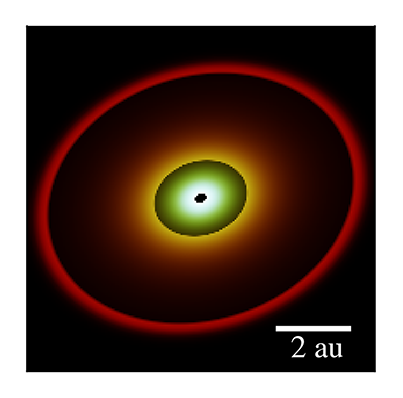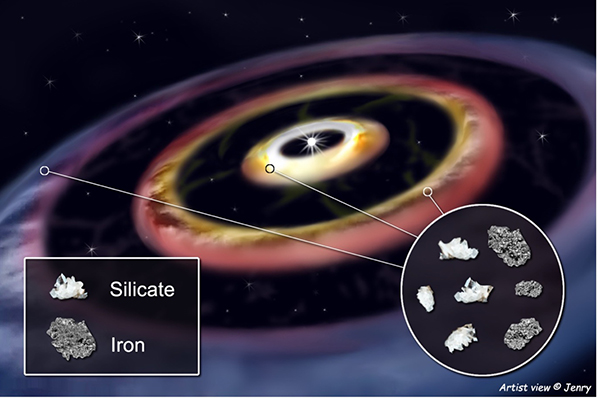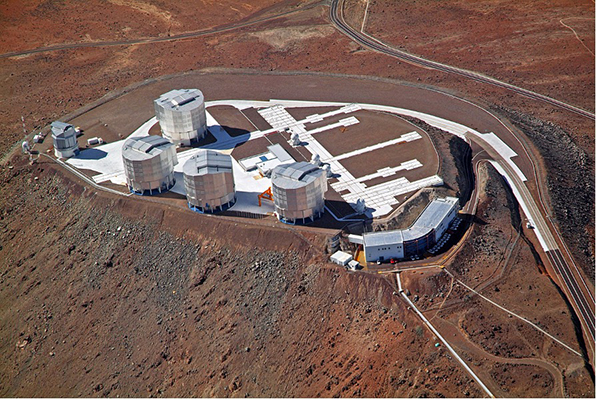How Earth and the Solar System were formed, is an age-old question of humankind. By studying the present state of our planet, scientists were able to trace back our planetary history to the very beginning. Now we know that Earth formed from the dust which encircled the newborn Sun 4.5 billion years ago.
An alternative approach to study the origin of our globe is to observe planetary systems currently in the making around distant young stars. An international team of astronomers observed such a system, a young star called HD 144432, surrounded by a dusty planet-forming disk at a distance of 500 light years. The researchers utilized the unique instrumentation suite of the Very Large Telescope Interferometer (VLTI) at the European Southern Observatory’s (ESO) Paranal Observatory in Chile. When studying the dust distribution in the innermost regions of this system where rocky planets can form, they detected for the first time a complex structure in which dust is concentrated in three rings. Compared to the Solar System, the first ring of HD 144432 is within the orbit of Mercury, the second ring is about the size of the orbit of Mars, and the third ring is close to Jupiter’s orbit.

Fig. 1 - The color composite model image of the inner disk around HD 144432, as seen by VLTI at infrared wavelengths. The scale is 2 astronomical units, which is twice the Earth-Sun distance.
The colors correspond to the following wavelengths : blue : 2.2 um, green : 4.75 um, red : 11.3 um. Note that the central star is not shown in this image.
Why are those rings important ? In most cases, extrasolar planets (outside of our Solar System) are too small and faint to be detected directly. However sufficiently massive planets, already present in the protoplanetary disk, clear gaps along their orbits. Thus, the ringed structure of the HD 144432 disk hints at the potential presence of unseen planets.
In addition, the astronomers studied the material composition of the dust in the disk, and there they found the most abundant building blocks that make up the core and mantle of Earth : magnesium, silicon, oxygen, and indications for an abundant presence of iron. So far, iron has only been suspected to be present in the inner disk regions. Remarkably, the new analysis prefers iron-rich and carbon-poor building blocks, which is similar to what we had on Earth. These results suggest that the chemical composition of Earth and other Solar System planets is not exceptional but may be fairly common in our Galaxy.

Fig. 2 - Artist’s impression. Credit: © Jenry.
The research is led by Dr. József Varga at the Konkoly Observatory, Budapest, Hungary. The research team is built around the VLTI/MATISSE and VLTI/GRAVITY instrument consortia, with the participation of colleagues from French, German, Dutch and Hungarian institutes, among others.

Fig 3 - Aerial view of the ESO Very Large Telescope (VLT), on top of Cerro Paranal, in the Atacama Desert, in Chile. The VLT interferometer (VLTI) combines the light of four telescopes, enabling high angular resolution imaging of distant celestial objects.
Credit : J.L. Dauvergne & G. Hüdepohl (atacamaphoto.com)/ESO
VLTI combines the light of four telescopes to obtain a virtual telescope with an effective diameter of about 130 m, which makes possible to resolve the details of a planet forming disk on a scale of a few milliarcseconds (a millionth of the apparent size of the Moon on the sky). While single existing 10-m telescopes would only give a blurry picture of the disk without any details, the so-called interferometric technique gives a huge boost in detail. As an example, with the VLTI’s resolution one could count the spots of a ladybug from 40 km (25 miles) afar.
Contacts
- Observatoire de Konkoly : József Varga, varga.jozsef@csfk.org
- Université de Leiden : Michiel Hogerheijde, michiel@strw.leidenuniv.nl
- Observatoire de la Côte d’Azur : alexis.matter@oca.eu ; Bruno Lopez@oca.eu
- Université Grenoble Alpes : karine.perraut@univ-grenoble-alpes.fr ; jean-charles.augereau@univ-grenoble-alpes.fr
- Commissariat à l’Energie Atomique de Saclay : eric.pantin@cea.fr
Référence
« Mid-infrared evidence for iron-rich dust in the multi-ringed inner disk of HD 144432 », Astronomy and Astrophysics, janvier 2024.
Read more : « Three iron rings in a planet-forming disk », Max Planck Institute.






